Electrical and Thermal Transport Properties of Layered Superconducting Ca10(Pt4As8)((Fe0.86Pt0.14)2As2)5 Single Crystal
Abstract
:1. Introduction
2. Material Preparation and Characterization Methods
3. Results and Discussion
4. Conclusions
Author Contributions
Funding
Conflicts of Interest
References
- Kakiya, S.; Kudo, K.; Nishikubo, Y.; Oku, K.; Nishibori, E.; Sawa, H.; Yamamoto, T.; Nozaka, T.; Nohara, M. Superconductivity at 38 K in Iron-Based Compound with Platinum–Arsenide Layers Ca10(Pt4As8)(Fe2−xPtxAs2)5. J. Phys. Soc. Jpn. 2011, 80, 093704. [Google Scholar] [CrossRef]
- Ni, N.; Allred, J.M.; Chan, B.C.; Cava, R.J. High Tc electron doped Ca10(Pt3As8)(Fe2As2)5 and Ca10(Pt4As8)(Fe2As2)5 superconductors with skutterudite intermediary layers. Proc. Natl. Acad. Sci. USA 2011, 108, E1019–E1026. [Google Scholar] [CrossRef] [PubMed]
- Lohnert, C.; Sturzer, T.; Tegel, M.; Frankovsky, R.; Friederichs, G.; Johrendt, D. Superconductivity up to 35 K in the iron-platinum arsenides (CaFe1−xPtxAs)10 (Pt4−yAs8) with layered structures. Angew. Chem. Int. Ed. 2011, 50, 9195–9199. [Google Scholar] [CrossRef] [PubMed]
- Ding, Q.P.; Tsuchiya, Y.; Mohan, S.; Taen, T.; Nakajima, Y.; Tamegai, T. Magnetic and transport properties of iron-platinum arsenide Ca10(Pt4−δAs8)(Fe2−xPtxAs2)5 single crystal. Phys. Rev. B 2012, 85, 104512. [Google Scholar] [CrossRef]
- Stürzer, T.; Derondeau, G.; Johrendt, D. Role of different negatively charged layers in Ca10(FeAs)10(Pt4As8) and superconductivity at 30 K in electron-doped (Ca0.8La0.2)10(FeAs)10(Pt3As8). Phys. Rev. B 2012, 86, 060516(R). [Google Scholar] [CrossRef]
- Ni, N.; Straszheim, W.E.; Williams, D.J.; Tanatar, M.A.; Prozorov, R.; Bauer, E.D.; Ronning, F.; Thompson, J.D.; Cava, R.J. Transport and thermodynamic properties of (Ca1−xLax)10 (Pt3As8)(Fe2As2)5 superconductors. Phys. Rev. B 2013, 87, 060507(R). [Google Scholar] [CrossRef]
- Sturzer, T.; Derondeau, G.; Bertschler, E.M.; Johrendt, D. Superconductivity by rare earth doping in the 1038-type compounds (Ca1−xREx)10(FeAs)10(Pt3As8) with RE = Y, La–Nd, Sm–Lu. Solid State Commun. 2015, 201, 36–39. [Google Scholar] [CrossRef]
- Yun, E.G.; Ahmad, D.; Kim, G.C.; Kwon, Y.S.; Kim, Y.C. Fishtail Effect and the Upper Critical Field in a Superconducting Ca10(Pt4As8)(Fe2−xPtxAs2)5. J. Supercond. Novel Magn. 2017, 30, 2963–2969. [Google Scholar] [CrossRef]
- Shen, X.P.; Chen, S.D.; Ge, Q.Q.; Ye, Z.R.; Chen, F.; Xu, H.C.; Tan, S.Y.; Niu, X.H.; Fan, Q.; Xie, B.P.; et al. Electronic structure of Ca10(Pt4As8)(Fe2−xPtxAs2)5 with metallic Pt4As8 layers: An angle-resolved photoemission spectroscopy study. Phys. Rev. B 2013, 88, 115124. [Google Scholar] [CrossRef]
- Luo, X.G.; Chen, X.H. Crystal structure and phase diagrams of iron-based superconductors. Sci. China Mater. 2015, 58, 77–89. [Google Scholar] [CrossRef]
- Al’tshuler, B.L.; Aronov, A.G. Influence of electron-electron correlations on the resistivity of dirty metals. JETP Lett. 1978, 27, 662–664. [Google Scholar]
- Al’tshuler, B.L. Temperature dependence of impurity conductivity of metals at low temperatures. Sov. Phys. JETP 1978, 48, 670–675. [Google Scholar]
- Shein, I.R.; Ivanovshii, A.L. Ab initio study of the nature of the chemical bond and electronic structure of the layered phase Ca10(Pt4As8)(Fe2As2)5 as a parent system in the search for new superconducting iron-containing materials. Theor. Exp. Chem. 2011, 47, 292–295. [Google Scholar] [CrossRef]
- Nakamura, H.; Machida, M. First-principles study of Ca–Fe–Pt–As-type iron-based superconductors. Phys. C Supercond. 2013, 484, 39–42. [Google Scholar] [CrossRef]
- Anderson, P.W. The Theory of Superconductivity in the High-Tc Cuprates; Princeton University Press: Princeton, NJ, USA, 1997; pp. 57–110. [Google Scholar]
- Moll, P.J.W.; Zhu, X.Y.; Cheng, P.; Wen, H.H.; Batlogg, B. Intrinsic Josephson junctions in the iron-based multi-band superconductor (V2Sr4O6)Fe2As2. Nat. Phys. 2014, 10, 644–647. [Google Scholar] [CrossRef]
- Ji, H.S.; Lee, G.; Shim, J.H. Small anisotropy in iron-based superconductors induced by electron correlation. Phys. Rev. B 2011, 84, 054542. [Google Scholar] [CrossRef]
- Blatter, G.; Feigel’man, M.V.; Geshkenbein, V.B.; Larkin, A.I.; Vinokur, V.M. Vortices in high-temperature superconductors. Rev. Mod. Phys. 1994, 66, 1125–1388. [Google Scholar] [CrossRef]
- Yamamoto, A.; Jaroszynski, J.; Tarantini, C.; Balicas, L.; Jiang, J.; Gurevich, A.; Larbalestier, D.C.; Jin, R.; Sefat, A.S.; McGuire, M.A.; et al. Small anisotropy, weak thermal fluctuations, and high field superconductivity in Co-doped iron pnictide Ba(Fe1−xCox)2As2. Appl. Phys. Lett. 2009, 94, 062511. [Google Scholar] [CrossRef]
- Kano, M.; Kohama, Y.; Graf, D.; Balakirev, F.; Sefat, A.S.; Mcguire, M.A.; Sales, B.C.; Mandrus, D.; Tozer, S.W. Anisotropy of the Upper Critical Field in a Co-Doped BaFe2As2 Single Crystal. J. Phys. Soc. Jpn. 2009, 78, 084719. [Google Scholar] [CrossRef]
- Jaroszynski, J.; Hunte, F.; Balicas, L.; Jo, Y.J.; Raicevic, I.; Gurevich, A.; Larbalestier, D.C.; Balakirev, F.F.; Fang, L.; Cheng, P.; et al. Upper critical fields and thermally-activated transport of NdFeAsO0.7F0.3 single crystal. Phys. Rev. B 2008, 78, 174523. [Google Scholar] [CrossRef]
- Gurevich, A. Enhancement of the upper critical field by nonmagnetic impurities in dirty two-gap superconductors. Phys. Rev. B 2003, 67, 184515. [Google Scholar] [CrossRef]
- Werthamer, N.R.; Helfand, E.; Hohenberg, P.C. Temperature and Purity Dependence of the Superconducting Critical Field, Hc2. III. Electron Spin and Spin-Orbit Effects. Phys. Rev. 1966, 147, 295–302. [Google Scholar] [CrossRef]
- Zhao, J.; Yao, D.X.; Li, S.L.; Hong, T.; Chen, Y.; Chang, S.; Ratcliff, W., II; Lynn, J.W.; Mook, H.A.; Chen, G.F.; Luo, J.L.; et al. Low Energy Spin Waves and Magnetic Interactions in SrFe2As2. Phys. Rev. Lett. 2008, 101, 167203. [Google Scholar] [CrossRef] [PubMed]
- Wang, C.; Li, Y.K.; Zhu, Z.W.; Jiang, S.; Lin, X.; Luo, Y.K.; Chi, S.; Li, L.J.; Ren, Z.; He, M.; et al. Effects of cobalt doping and phase diagrams of LFe1−xCoxAsO (L = La and Sm). Phys. Rev. B 2009, 79, 054521. [Google Scholar] [CrossRef]
- Li, L.J.; Wang, Q.B.; Luo, Y.K.; Chen, H.; Tao, Q.; Li, Y.K.; Lin, X.; He, M.; Zhu, Z.W.; Cao, G.H.; et al. Superconductivity induced by Ni doping in BaFe2As2. New J. Phys. 2009, 11, 025008. [Google Scholar]
- Uher, C.; Huang, W.N. Thermoelectric power and thermal conductivity of neutron-irradiated YBa2Cu3O7−δ. Phys. Rev. B 1989, 40, 2694–2697. [Google Scholar] [CrossRef]
- Krishana, K.; Ong, N.P.; Li, Q.; Gu, G.D.; Koshizuka, N. Plateaus Observed in the Field Profile of Thermal Conductivity in the Superconductor Bi2Sr2CaCu2O8. Science 1997, 277, 83–85. [Google Scholar] [CrossRef]
- Sefat, A.S.; Mcguire, M.A.; Sales, B.C.; Jin, R.; Howe, J.Y.; Mandrus, D. Electronic correlations in the superconductor LaFeAsO0.89F0.11 with low carrier density. Phys. Rev. B 2008, 77, 174503. [Google Scholar] [CrossRef]

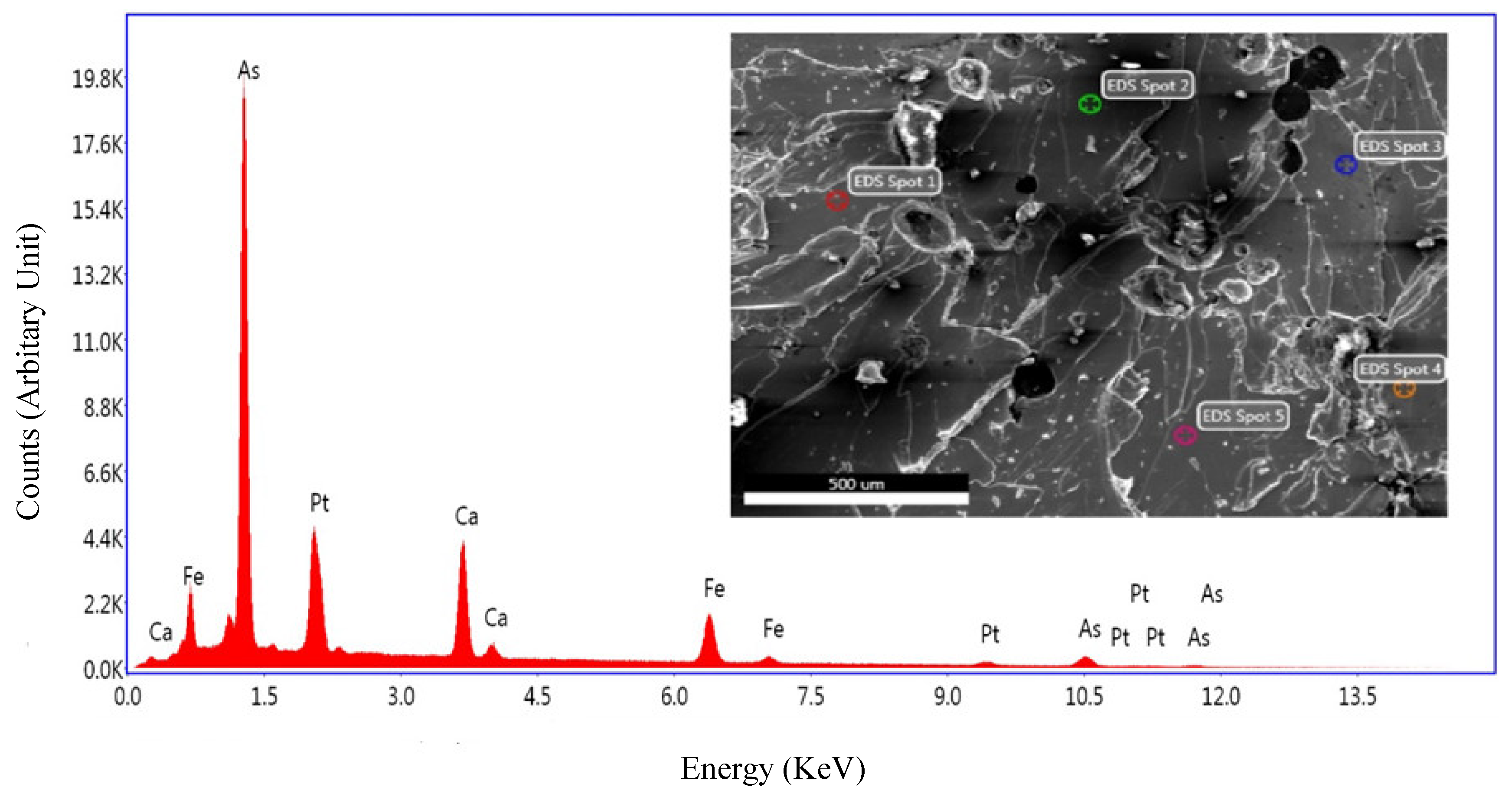

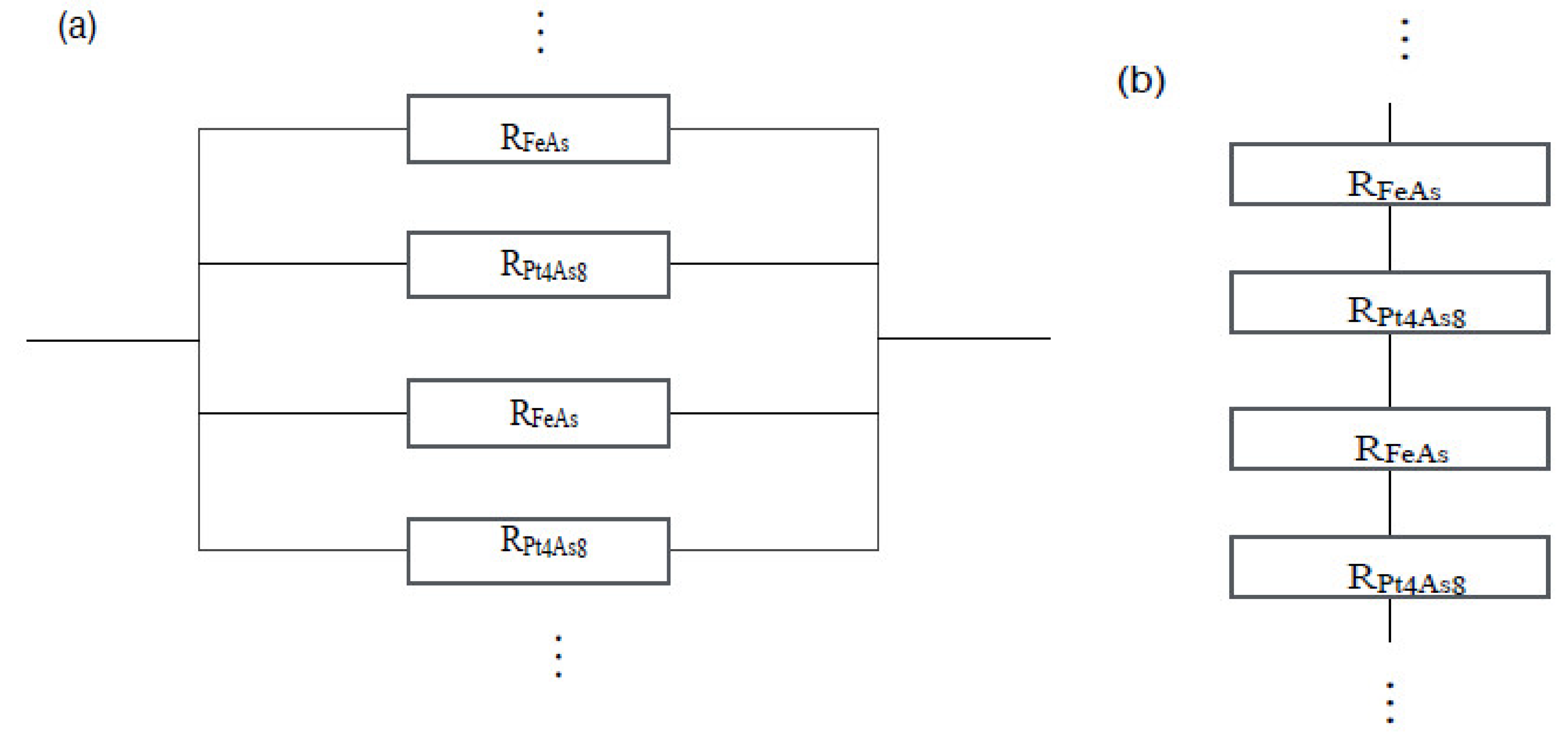


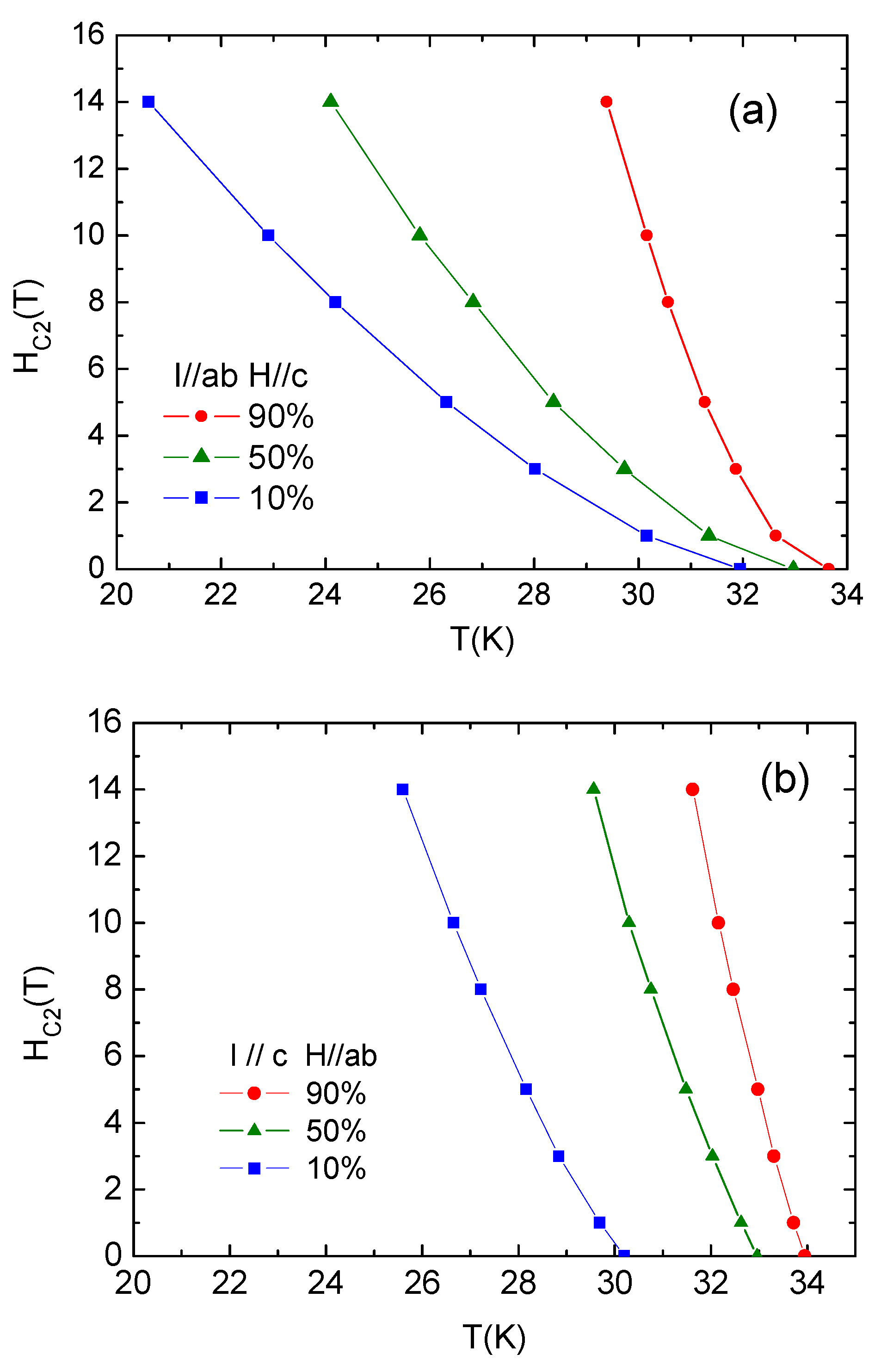
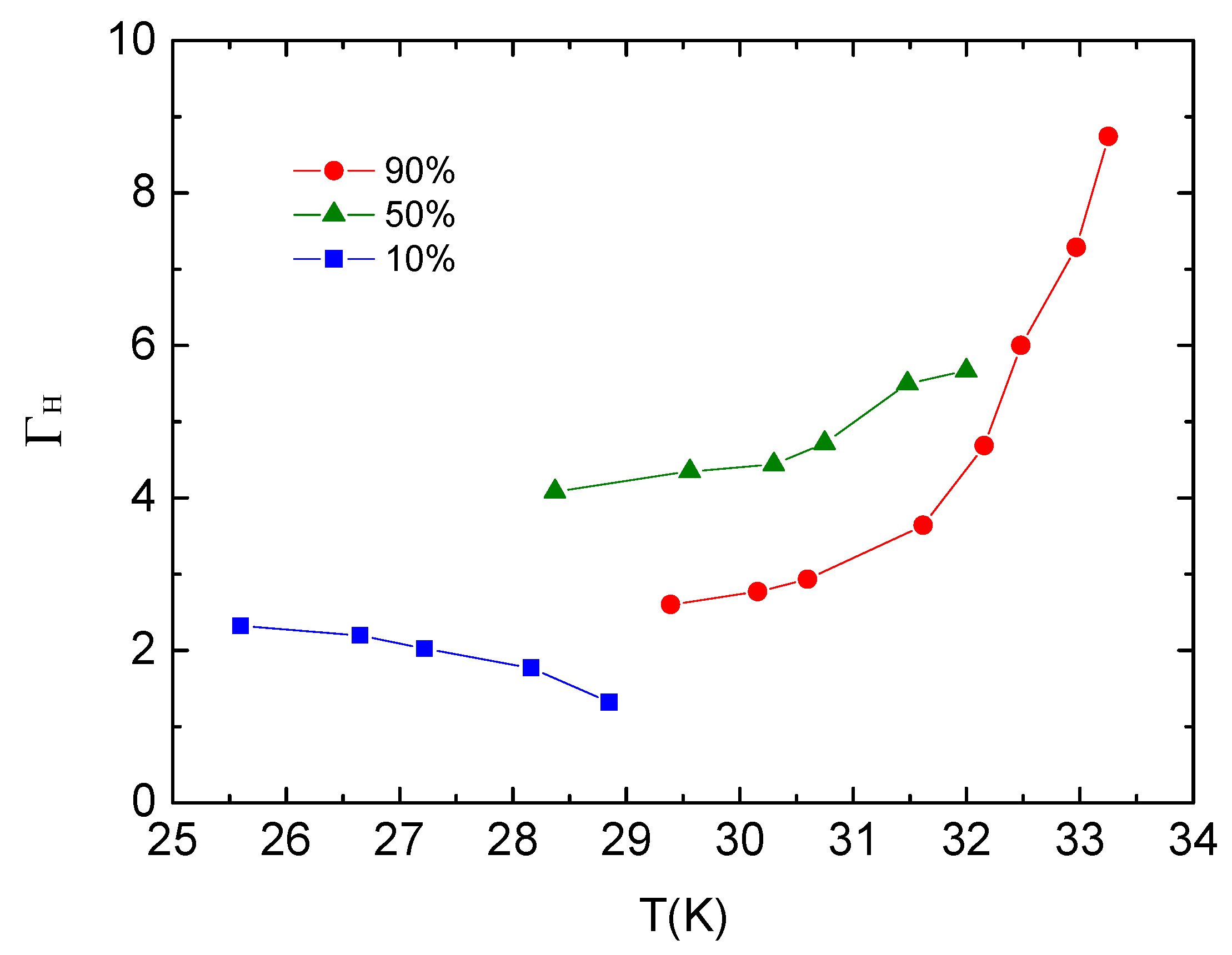

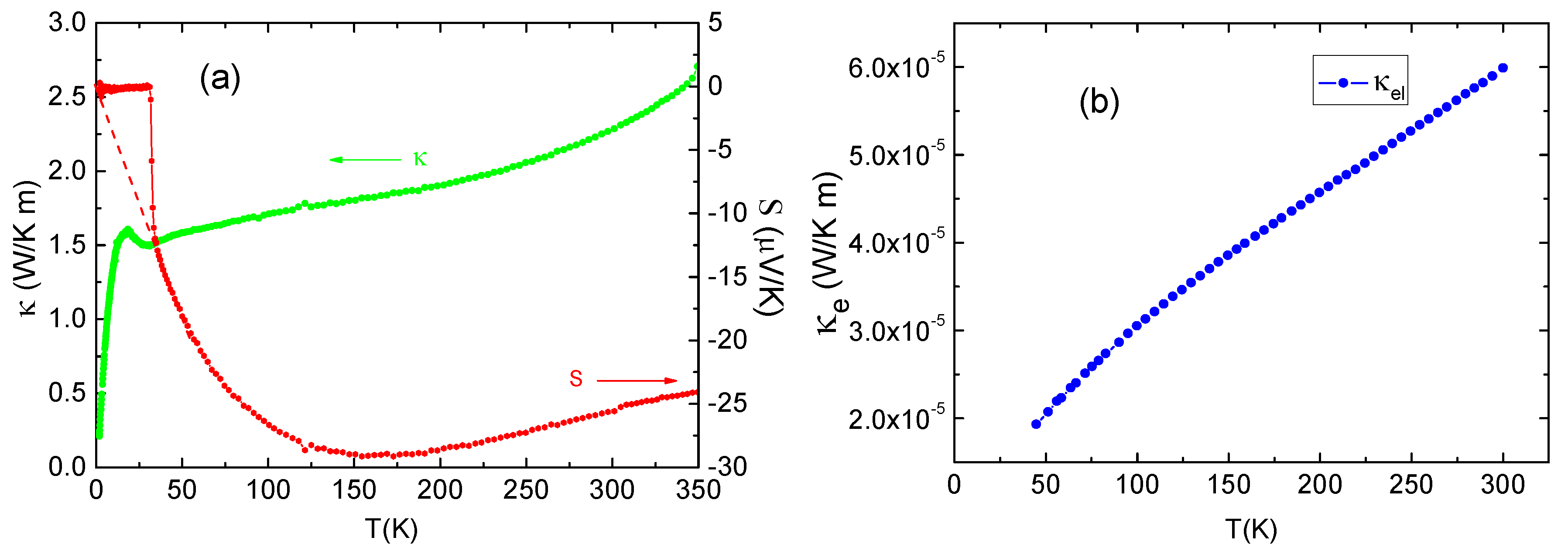
| Criteria in Determining Hc2 | (Tesla) (WHH Approach) | (Tesla) (WHH Approach) | ξab(0) (Å) | ξc(0) (Å) | ||
|---|---|---|---|---|---|---|
| 0.9 ρn | −6.5 ± 0.2 | 138 ± 5 | −14.1 ± 0.1 | 313 ± 6 | 15.5 ± 0.2 | 6.8 ± 0.3 |
| 0.5 ρn | −0.89 ± 0.1 | 19.7 ± 2 | −4.4 ± 0.1 | 99 ± 2 | 40.9 ± 0.5 | 8.1 ± 0.3 |
| 0.1 ρn | −0.74 ± 0.1 | 16.4 ± 1 | −3.8 ± 0.1 | 84 ± 3 | 44.8 ± 0.4 | 8.7 ± 0.5 |
© 2019 by the authors. Licensee MDPI, Basel, Switzerland. This article is an open access article distributed under the terms and conditions of the Creative Commons Attribution (CC BY) license (http://creativecommons.org/licenses/by/4.0/).
Share and Cite
Wu, D.; Meng, X.; Zhai, Y.; Yu, H.; Yu, J.; Qi, Y. Electrical and Thermal Transport Properties of Layered Superconducting Ca10(Pt4As8)((Fe0.86Pt0.14)2As2)5 Single Crystal. Materials 2019, 12, 474. https://doi.org/10.3390/ma12030474
Wu D, Meng X, Zhai Y, Yu H, Yu J, Qi Y. Electrical and Thermal Transport Properties of Layered Superconducting Ca10(Pt4As8)((Fe0.86Pt0.14)2As2)5 Single Crystal. Materials. 2019; 12(3):474. https://doi.org/10.3390/ma12030474
Chicago/Turabian StyleWu, Dapeng, Xiaodong Meng, Yingying Zhai, Huaming Yu, Jiao Yu, and Yang Qi. 2019. "Electrical and Thermal Transport Properties of Layered Superconducting Ca10(Pt4As8)((Fe0.86Pt0.14)2As2)5 Single Crystal" Materials 12, no. 3: 474. https://doi.org/10.3390/ma12030474




